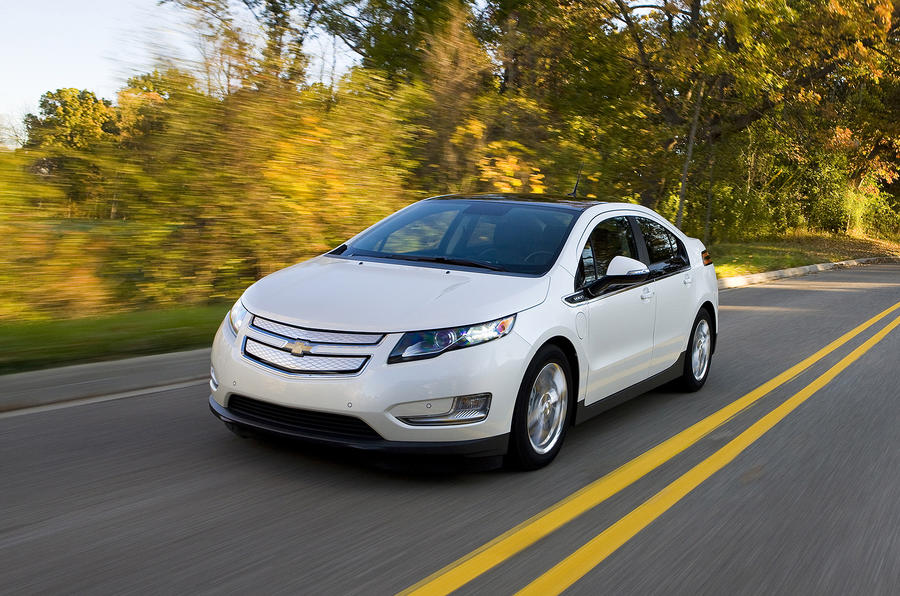What is it?
The future. Chevrolet is not only the first maker to bring a serious series-production battery-powered car to the market, it has, arguably, come up with the most technically intriguing solution.
General Motors insists that the Volt is not a hybrid but an ‘extended range electric vehicle’, making it the first production battery-powered car that can promise not to leave the driver stranded at the side of the road.
GM's announcement on the inner-workings of the Volt's innovative and complex powertrain hit the headlines last week over just what the car should be classified as. Ignoring the semantics, GM will argue that the Volt’s unique layout is best placed to offer the potential of both a purely battery-powered commute during the week and pretty frugal, mostly petrol-powered, longer journeys at the weekend.
The car is based on GM’s new Delta platform, which also underpins the new Astra and Chevy Cruze. It uses the same basic McPherson suspension and the clever U-section Torsion beam axle. Unfortunately, the Volt’s back axle does without the Astra’s clever Watts link. The Volt gets also unique, lightweight wheels and specific Goodyear low-friction tyres.
What’s it like?
There’s virtually no noise when you press the illuminated start button and you only have to pull the (disappointingly awkward and clunky) shift lever into ‘D’ mode to make a silent getaway.
The smooth torque of the electric motors does a surprisingly good job of disguising the Volt’s 1715kg kerb weight. However, like the Prius, the Chevy seems to encourage the driver to flow along gently, rather than to push on.
This is probably a combination of the steady swell of torque, lack of gear changes, the silence of the drivetrain and the dash graphic counting down the distance to discharge.
Even under reasonable acceleration on the local freeways, the Volt’s battery-driven drivetrain mode remains relaxed and refined. There’s none of the audible strain of the racing engine and CVT ‘box that can blight the Prius.
When the battery is dead, the Volt can pull away on battery’s buffer store and then the engine cuts very quietly at around 20mph to power-up the motor/generator. Only under hard acceleration above, say, 50mph is the engine properly audible. It’s not noisy, but it’s not the most engaging sound either.
On the arrow-straight roads of rural Michigan, it was hard to establish whether the Volt has a spark of enthusiasm for being driven briskly, but what we did experience didn’t bode well.
The steering suffers from nearly a quarter of a turn of light and feel-less response (likely to be partly tyre-related). On Michigan’s hideously broken concrete roads, the Volt suffered from very intrusive bump-thump, though the ride was actually pretty good.
Otherwise it has a very quiet cabin (making front and rear conversation easy) and left me quite refreshed after a few hours at the wheel. Overall, the Volt is easy, fluid and breezy as befits a car tuned entirely for frugality.
Styling-wise, while the Volt’s filmically futuristic exterior is neatly executed, it’s the interior ambience that really impresses.
































Join the debate
Add your comment
Chevrolet Volt ~ No Doubt Car Of The Future
I drove to Spain in September 2012 and achieved about 53mpg. The main issue being, that there were no available electric points to charge up the Volt. Only one garage in France, had an earth pin added to a two pin socket, and I charged up using a Shuko adapter whilst having a much needed kip. As Volt owners may already know, a well grounded earth pin is required for the charging to activate and in Europe, especially Spain, they're all two pin only. Since holidaying abroad, I have searched all the local garages, workshops, hotels etc., and can't find any compatible sockets to charge the Volt. So, it's not the Volts' low to average mpg when driving long distances, it's the lack of available plug-in points!
Re: Chevrolet Volt
A quick n dirty calculation based on the average mileage for a family car, 12,000 which is 32 miles a day. Of course, many households do less than this on a yearly basis, say 9,000, if the car is used for only 80% of all journeys, that cwould roughly equate to 300 days usage, which is 30 miles a day on average. I doubt many households live more than 20 miles from work or the nearest Tesco for the weekly shop. I have a feeling that if you actually look into the driving habits of most families or households in the UK or elsewhere, the number of miles or kilometers is significantly less than what is perceived to be the 'average'. Of course if you are a rep pounding up the M1 on a daily basis then this car is not for you. There are specific situations that a car like this or the Leaf would make sense. If you fit the criteria, then why not go for it? It applies to every other car out there.
Re: Chevrolet Volt
Wrong yet again.
2 sources:
Source 1.
Source 2.